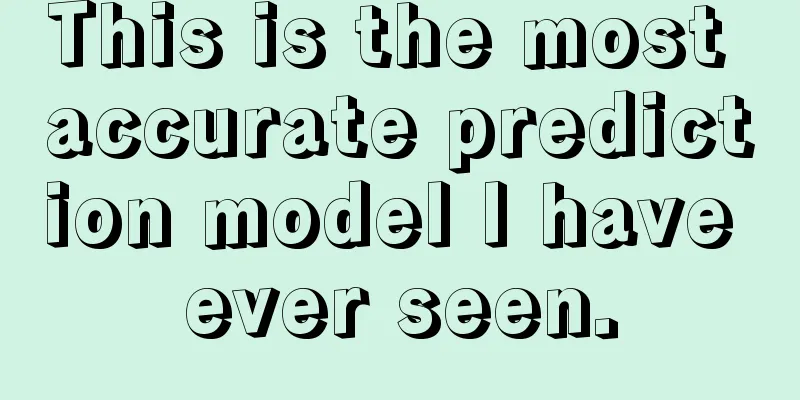This is the most accurate prediction model I have ever seen.

1. The Nature of Prediction AlgorithmsEssentially, there are only two categories of prediction algorithms: 1. Time series based
2. Based on causality
It is possible that when modeling, instead of using a single model to cover everything, a two-stage model is used. For example, to predict the consumption of a customer group, a binary classification model can be used to predict whether or not to consume, and a continuous model can be used to predict the consumption amount. In this way, the total consumption can be obtained by multiplying the number of users who will consume by the predicted consumption amount. This is a typical processing method. This is what the books teach, but why is it that it is beaten to pieces when faced with reality? 2. Key points of prediction algorithmBecause: In order to highlight the model effect, the book deliberately selected data sets with good quality and complete data. In reality, troubles are endless: 1. No dataOften, the data to be predicted is just one line of "total monthly consumption", with no other data at all... 2. Still no dataMany companies cannot get first-hand data from Tmall, Douyin, and Amazon, and can only use the little data exported from the backend to mess around... 3. There is no dataMost companies are not monopoly companies like Touteng'a, which only have very one-sided data. Most commonly, most companies' users are attracted by spending money, and the users only have a mobile phone number + a preferential order... This leads to a funny situation: many companies use causal relationship models, and the variable with the greatest impact must be the promotion intensity. Even if the stepwise regression method is used to model, the variable of promotion intensity can directly eliminate all other variables. The prediction result becomes: the greater the promotion intensity, the more users will join and the more they will buy. Once this kind of result is thrown out, the business will definitely comment: "It's all bullshit, I knew it a long time ago!" This is the second biggest problem in reality: how to measure business results. For example, the predicted sales volume is 10 million
In short, as long as you are not 100% accurate, they will have a reason to blame you. They can even jump back and forth. For example: "The business could have met the target, and when we saw the forecast said it could meet the target, we saved some money. In the end, it didn't meet the target, and it's all because the forecast interfered with the business judgment..." How to break the deadlock? Since the problem is caused by people, of course it must be solved by people. Avoiding life-threatening predictions and starting from the perspective of business scenarios to eliminate human influence is the key to solving the problem. 3. Avoid forecasting errors through business operationsIn some scenarios, the problem can be solved directly through business operations. In this case, use business methods directly instead of modeling. for example:
Almost all Internet marketing models, from Xiaomi to Tmall to Pinduoduo, are actually fighting against the problem of stocking due to insufficient data. So don’t just stare at other people’s models, but also learn from their operations. 4. Use fundamental analysis to narrow the forecast rangeAll life-gambling predictions have one thing in common: they must be neither too high nor too low to be considered accurate. For example, in a typical sales performance forecast, if the actual sales performance is 10 million, the forecast must reach 10 million to be considered accurate. This is the root cause of the problem that the model is evaluated as "inaccurate". Back to the business scenario, in fact, most business scenarios do not require this level of accuracy. Most of the time, the business is afraid of a sudden surge/surge. Instead of setting the prediction target as "100% accurate", it is better to set it as "whether the surge/surge exceeds the business's digestion capacity". It is basically impossible to predict with 100% accuracy, but it is easy to find where the price may surge or plummet. By using basic analysis to distinguish unstable factors, the difficulty of prediction can be greatly reduced (as shown in the figure below). After doing a good job of basic analysis and breaking down unstable factors, it will be easier to select model combinations and solve problems (as shown below). 5. Use rolling forecasts instead of long-term forecastsAll gamble predictions have a long prediction period, which can be as long as one year or as short as one month. The gamble period is too long, and very little data can be collected in the early stage, and it is impossible to reflect the various intermediate operations of the business department, so it is very passive. Rolling forecasts can largely make up for this shortcoming. Daily/weekly rolling forecasts can not only supplement missing data, but also reflect the effects of temporary adjustments made by the business side, killing two birds with one stone (as shown in the figure below). 6. Protect yourself with the buy-and-leave modelA good question + rolling forecast can basically meet the actual work needs. But as a forecaster, you have to learn to protect yourself and avoid the business side repeatedly making mistakes and blaming others. The buy-and-leave method is a good way. After the forecast results are given, all relevant business parties will no longer question the forecast results, but will make additions based on the forecast results. If anyone feels that the forecast is too small, he or she can write a request to apply for additional goods and leave written evidence. Then it will be clear whether the forecast is inaccurate or the business person applied for too much and the goods cannot be sold (as shown in the figure below). 7. A deeper look at the prediction problemBehind the forecasting problem is a deeper business problem: in many companies, the loss of inventory backlog is visible, and the goods are rotting in the warehouse. However, the potential sales loss due to out-of-stock is not seriously counted. It is easy to count the loss due to out-of-stock, as customers can pay a deposit to make an appointment, and can register the demand and time of demand. However, many companies are either lazy, stupid, or do not want to take responsibility, and in short, they do not do it. Pre-sales, group purchases, hunger marketing, deposit inflation, out-of-stock registration... All business methods require not only operational capabilities, but also system construction support. Obviously, for the business, it is easier to directly blame "inaccurate model prediction" than to engage in these system construction and complex operational methods. Therefore, if you ask the business directly about the forecasting needs, they will tend to bet on the "not too high, not too low, just right" prediction. But this is obviously unfair to data analysts. Since the potential losses cannot be measured, the actual backlog is intuitively visible, so as a data analyst, as long as you take care of the backlog losses, you can make a contribution. That's why there are all these operating methods. Author: Down-to-earth Teacher Chen Source: WeChat public account "Down-to-earth Teacher Chen (ID: gh_abf29df6ada8)" |
>>: The seven hot content theme trends in Xiaohongshu’s maternal and child track in 2023 are here!
Recommend
As we enter the stage of deep cultivation of all channels, how can snack food brands achieve certain growth?
In the process of channel transformation, what cha...
If you set up a stall selling grilled sausages, how can you stand out from the crowd?
Nowadays, with the prevalence of the stall economy...
Advertisers, please check: 6 love letters from brands
What new styles will brand copywriting have this V...
Which platform is better for novice cross-border e-commerce merchants to enter? Can one person do cross-border e-commerce?
For newcomers, choosing a suitable cross-border e-...
Want to win the battle for overseas traffic? Don’t miss these festivals in December this year!
This article starts from overseas history and cult...
How to choose brands and categories for cross-border e-commerce without source of goods?
As a flexible and low-cost business model, cross-b...
Brand Tragedy
Brand is the most distinctive and recognizable sym...
Lazada LazCoins Launches New Benefits
Lazada LazCoins launches new benefits. During this...
How should marketers properly utilize ChatGPT?
ChatGPT's capabilities have been widely recogn...
Can't spend money on Xiaohongshu? There are too few bloggers in the category to cooperate with? How to solve these two problems!
Can't spend money on Xiaohongshu? There are to...
How long does it take for Amazon DHL to clear customs? What should I pay attention to when shopping on Amazon?
There are actually quite a lot of merchants doing ...
A comprehensive article on how to use the closed-loop harvesting method of Xiaohongshu marketing components and comment area components!
Starting from the comment area component, this art...
The number of fans increased by over 3 million in one month. This generation of young people has their own "Animal World"
This article deeply analyzes the phenomenon of &qu...
Xiaohongshu’s standardized process for post-investment review
Exploring the review methods of Xiaohongshu’s adve...
Samsung's new ad contains hints about Apple, is this competitive promotion always effective?
This article specifically introduces the business ...









